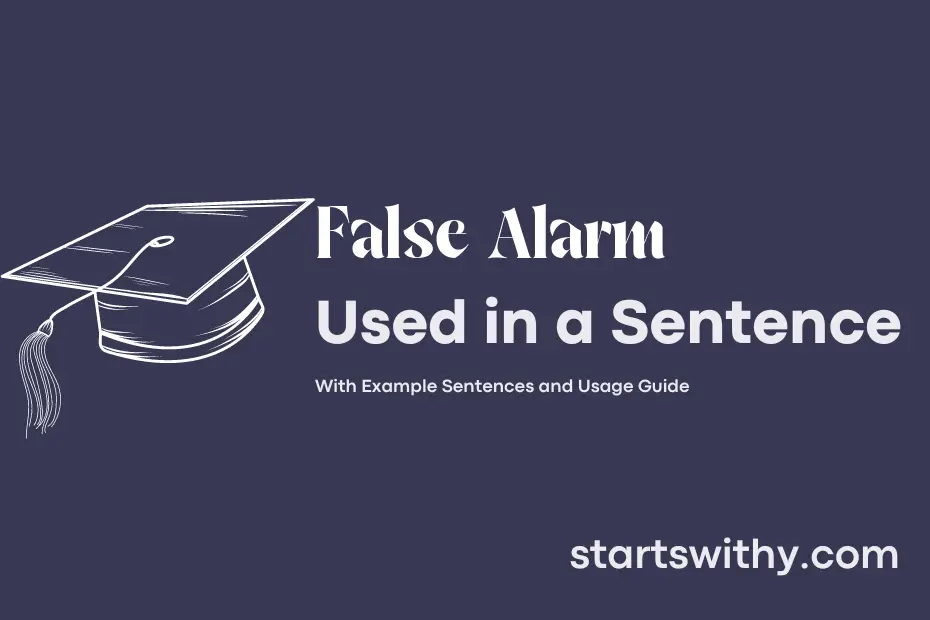Have you ever experienced a false alarm? A false alarm is a situation where an alert or warning is triggered, causing people to believe there is an emergency when there isn’t one.
False alarms can occur for various reasons, such as technical malfunctions, human error, or misinterpretation of data. These incidents can lead to unnecessary panic, wasted resources, and a loss of credibility in the system issuing the alert.
7 Examples Of False Alarm Used In a Sentence For Kids
- The loud noise outside was just a false alarm.
- Don’t worry, the fire drill was only a false alarm.
- The teacher thought there was a bug, but it was just a false alarm.
- The bell ringing during lunch was a false alarm, we still have time to eat.
- There was no need to worry, it was just a false alarm.
- The cat’s loud meow sounded like a false alarm.
- The storm clouds passed by without any rain, it was a false alarm.
14 Sentences with False Alarm Examples
- False alarm! The professor postponed the exam to next week.
- It was just a false alarm. The library didn’t close early today.
- I thought my assignment deadline was today, but it was just a false alarm. It’s actually due next week.
- The notice about the class cancellation was a false alarm. The lecture will proceed as scheduled.
- I panicked when I thought the campus was closing due to bad weather, but it was just a false alarm.
- The rumor about the plagiarism checker malfunctioning was a false alarm. The system is working fine.
- I rushed to submit my project 30 minutes early, only to realize it was a false alarm. The deadline was still hours away.
- The announcement of a strike by the college staff turned out to be a false alarm. Classes continued as usual.
- I got worried when I heard the canteen would be closed, but it was just a false alarm. It was open for business.
- The email stating that the Wi-Fi would be down for maintenance was a false alarm. The connection was not affected.
- A fellow student’s warning about a fire drill happening today was a false alarm. No drill took place.
- I received an alarming message about a virus outbreak on campus, but it was a false alarm. Everything was under control.
- The message about the cancellation of the cultural fest was a false alarm. The event was still on track.
- The notification about the end semester exam dates being changed was a false alarm. The original schedule remained unchanged.
How To Use False Alarm in Sentences?
To use “False Alarm” in a sentence, you must understand its meaning and context. “False Alarm” refers to an instance where a warning or alarm is triggered, but nothing dangerous or serious actually occurs. To effectively incorporate this phrase into a sentence, follow these simple steps:
-
Identify a situation where a warning or alarm was sounded but turned out to be unnecessary. For example, “The fire alarm at school was a false alarm caused by burnt popcorn in the cafeteria.”
-
Introduce the phrase “False Alarm” into the sentence in a way that conveys the idea that the alarm was unwarranted or mistaken. For instance, “The security guards quickly realized that the supposed break-in was just a false alarm triggered by a faulty sensor.”
-
Ensure that the context of the sentence makes it clear that the alarm was incorrect or unnecessary. This will help emphasize the meaning of “False Alarm.” For example, “We panicked when the earthquake alarm went off, only to find out it was a false alarm caused by a minor tremor.”
By following these steps, you can effectively use “False Alarm” in a sentence to convey the message that a warning or alarm was mistakenly triggered.
Conclusion
In conclusion, false alarms are situations where warnings or alerts are issued based on incorrect information or misinterpretation, leading to unnecessary panic or concern. These false alarms can cause disruptions, waste resources, and strain emergency services. Examples of sentences with false alarms include “The fire alarm rang, but it was just a false alarm triggered by burnt popcorn in the microwave” and “The security system went off, but it was a false alarm caused by a pet wandering into the motion sensor’s range.”
It is essential to verify and confirm the authenticity of alarms before reacting to them to prevent unnecessary alarm and confusion. Therefore, proper protocols, regular maintenance checks, and effective communication are crucial in minimizing the occurrence of false alarms and ensuring a prompt and appropriate response when they do happen.



